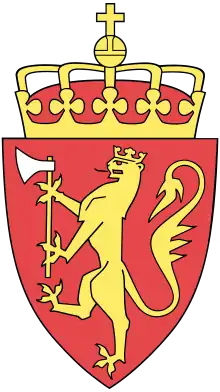Lom, Norway
Lom is a municipality in Innlandet county, Norway. It is part of the traditional region of Gudbrandsdal. The administrative centre of the municipality is the village of Fossbergom. The municipality of Lom was established on 1 January 1838 (see formannskapsdistrikt). The area of Skjåk was separated from Lom to become a municipality of its own in 1866.
Lom kommune | |
|---|---|
 | |
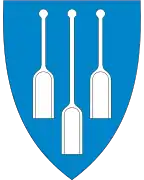 Coat of arms 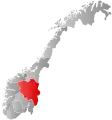 Innlandet within Norway | |
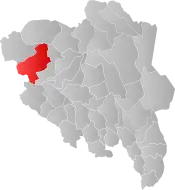 Lom within Innlandet | |
| Coordinates: 61°48′39″N 8°38′21″E | |
| Country | Norway |
| County | Innlandet |
| District | Gudbrandsdal |
| Administrative centre | Fossbergom |
| Government | |
| • Mayor (2017) | Bjarne Eiolf Holø (Sp) |
| Area | |
| • Total | 1,969 km2 (760 sq mi) |
| • Land | 1,889 km2 (729 sq mi) |
| Area rank | 31 in Norway |
| Population (2016) | |
| • Total | 2,347 |
| • Rank | 303 in Norway |
| • Density | 1/km2 (3/sq mi) |
| • Change (10 years) | −5.0% |
| Demonym(s) | Lomvær[1] |
| Time zone | UTC+01:00 (CET) |
| • Summer (DST) | UTC+02:00 (CEST) |
| ISO 3166 code | NO-3434 |
| Official language form | Nynorsk[2] |
| Website | www |
Lom is famous for its extensive history, for having one of the few remaining stave churches in Norway, and for lying in the midst of the highest mountains in Northern Europe.
General information
Name
The Old Norse form of the name was Lóar (nominative case) and Lóm (dative case). The name is the plural form of ló which means "meadow". [3]
Coat-of-arms
The coat-of-arms is from modern times. They were granted on 6 February 1987. The arms show three silver-colored skjeltrekor (spades) on a blue background. These spades were historically used to scoop water from the irrigation channels typical for the area. The area is one of the driest in Norway, but the soil is good for agriculture. It thus needs irrigation. In the 17th century, a system was developed in which melting water from the mountains was transported to the area using wooden channels or aqueducts. The water was further divided using irrigation channels.[4]
| Ancestry | Number |
|---|---|
| 31 | |
| 18 | |
| 17 |
History
An ancient trade route passed up from Sunnmøre through Lom and Skjåk and down the Gudbrandsdal into the Østlandet. The trade consisted of fish and salt heading inland, and grain heading to the coast.
The Saga of Olaf Haraldson relates that St. Olaf commented as he first looked down on Lom, "What a pity to have to lay waste to such a beautiful valley." In the face of such a clear motivation, the residents of the valley converted (it has since been a recurring discussion whether he looked to Lom or the neighbouring municipality Skjåk, at the time a part of Lom.) St. Olafs-stuggu, a building where St. Olaf is reported to have spent a night in 1021, can still be found here. The building is part of the Presthaugen District Museum.
Lom stave church, which is located at Lom center, is believed to have been built in 1158, making 2008 the 850th anniversary. It was extended in 1634, with further addition of two naves in 1667. It is believed that the church was originally surrounded by a circumambulatory passage, like many other Norwegian stave churches, but that this passage was removed when the two side wings were added. A few Runic inscriptions can be still be seen in the church. The church also contains numerous paintings from the 17th and 18th centuries with religious motifs. Many of the paintings were made by local artist Eggert Munch, a distant relation of the famous Edvard Munch. The church also contains numerous examples of local woodcarving, as seen in the elaborate acanthus scrolls adorning the pulpit. Carved dragon figures on the roof are old symbols of protection against evil. It is still in use as the local church.
The Garmo Stave Church, which was built around 1150, has been relocated from Lom municipality and is now at Maihaugen in Lillehammer.
During the 1940 Norwegian Campaign German prisoners of war were kept by the Norwegian Army at Lom prisoner of war camp. Lom was bombed twice by the German Luftwaffe in April 1940.[6]
Geography
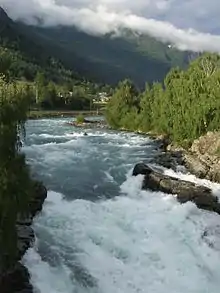
Lom is the "gateway" to the Jotunheimen Mountains and to Jotunheim National Park. The municipality contains the two highest peaks in Norway, Galdhøpiggen at 2,469 metres (8,100 ft) and Glittertind at 2,464 metres (8,084 ft), which lie within the park.
Lom is bordered on the northwest by the municipality of Skjåk, in the north by Lesja, in the east and southeast by Vågå, in the south by Vang all in Oppland county. In the southwest, it is bordered by Luster municipality in Sogn og Fjordane county. The village of Lom is situated in a valley at an elevation of 382 metres (1,253 ft) above sea level.
Climate
The climate is very continental by Norwegian standards. Average annual precipitation (in Fossbergom) is 321 millimetres (12.6 in), and monthly 24-hr averages range from −10 °C (14 °F) in January to 14 °C (57 °F) in July.[7] Summers are often sunny with daytime temperatures typically ranging from 14 °C (57 °F) to 25 °C (77 °F). The large mountain areas in Lom are much colder and have more precipitation; snowy weather is possible even in summer at altitudes above 2,000 metres (6,600 ft). Agriculture has for centuries used irrigation.
Economy
Agriculture has long been important in Lom. The natural environment and history of this mountainous region also make Lom a tourist destination.
Notable residents
- Jakob Klukstad (1705 in Lom – 1773) a Norwegian wood carver and painter
- Knut Hamsun (1859 in Lom – 1952) novelist, winner of the 1920 Nobel Prize in Literature. His childhood home can be seen 12 kilometers to the east of Lom center
- Erland Frisvold (1877 in Lom – 1971) politician and Army colonel
- Olav Aukrust (1883 in Lom – 1929) a poet and teacher, used Nynorsk. There is a memorial to him near the church
- Jørgine Boomer (1887 in Bøverdalen – 1971) a Norwegian-American rags-to-riches hotel manager
- Carl Gustav Sparre Olsen (1903–1984) a Norwegian violinist and composer, buried in Lom
- Tor Jonsson (1916 in Lom – 1951), poet and author and winner of The Norwegian Critics Prize for Literature. His childhood cottage is part of the Lom District Museum on the sunny-side road Solsidevegen
- Arne Brimi (born 1957) a Norwegian chef and food writer
- Morten Schakenda (born 1966) a Norwegian cook
Attractions

- Lom Stave Church
- Jotunheim National Park
- Norsk Fjellmuseum, the Norwegian Mountain Museum and information center for Jotunheim National Park
- Lom District Museum in Presthaugen – an open-air museum
- Fossheim Stone/Mineral Center
- Route 55 the Sognefjellsvegen from Lom over the Sognefjell (the highest mountain pass in Northern Europe)
- Knut Hamsun's cottage located at Garmostrædet
- The Sagasøyla Column in Bøverdalen
- Lom's irrigation canals
References
- "Navn på steder og personer: Innbyggjarnamn" (in Norwegian). Språkrådet.
- "Forskrift om målvedtak i kommunar og fylkeskommunar" (in Norwegian). Lovdata.no.
- Rygh, Oluf (1900). Norske gaardnavne: Kristians amt (in Norwegian) (4 ed.). Kristiania, Norge: W. C. Fabritius & sønners bogtrikkeri. p. 47.
- Norske Kommunevåpen (1990). "Nye kommunevåbener i Norden". Retrieved 4 January 2009.
- "Immigrants and Norwegian-born to immigrant parents, by immigration category, country background and percentages of the population". ssb.no. Archived from the original on 2 July 2015. Retrieved 26 June 2017.
- Mølmen 1996: 325
- "Met.no". Archived from the original on 4 February 2005.
Bibliography
- Mølmen, Øystein (1996). Krigen 1940–45 (in Norwegian). Lesjaskog: Ø. Mølmen. ISBN 82-993958-0-1.
External links
| Wikimedia Commons has media related to Lom, Norway. |
| Look up Lom in Wiktionary, the free dictionary. |
- Municipal fact sheet from Statistics Norway
 Oppland travel guide from Wikivoyage
Oppland travel guide from Wikivoyage- www.jotunheimen.com
